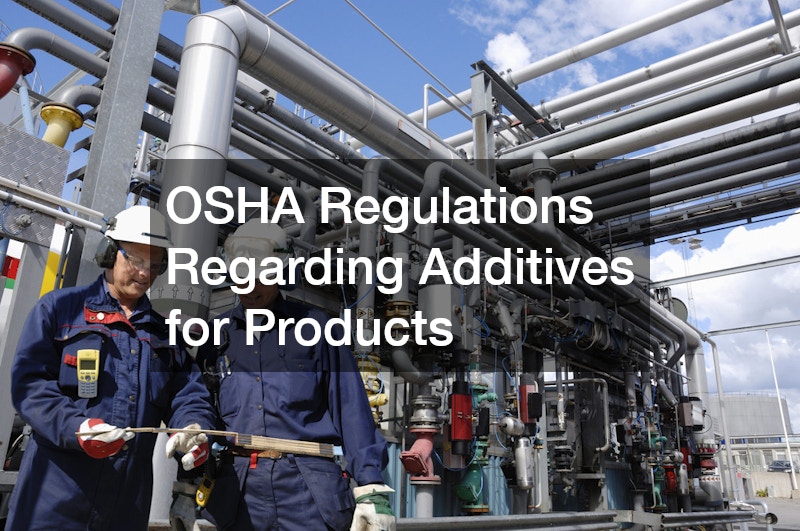
In the chemical and petrochemical industry, workplace safety is paramount for the top specialty chemical supplier, particularly when handling chemical additives for products. The Occupational Safety and Health Administration (OSHA) plays a vital role in establishing guidelines that protect workers from hazardous exposures. Understanding OSHA’s regulations on chemical additives is essential for employers and employees in this high-risk sector, where exposure to reactive or toxic substances is a daily concern.
OSHA’s Role in Chemical Safety
OSHA regulates occupational exposure to hazardous substances, including additives for products, through a set of rules and standards designed to reduce health risks. One of the main tools OSHA uses to enforce these protections is the establishment of permissible exposure limits, also known as PELs. According to the National Library of Medicine, OSHA can set PELs limiting the concentration of a chemical substance or physical agent individuals may be occupationally exposed to over an eight-hour period, which is the typical length of a work shift. These limits are designed to minimize the risk of both immediate and long-term health effects from repeated or prolonged exposure to potentially harmful substances.
Beyond setting limits, OSHA also requires that businesses provide employees with access to Safety Data Sheets (SDS), proper labeling of hazardous materials, and training on safe handling practices. Employers must also implement engineering controls, personal protective equipment, and regular monitoring to verify compliance. Working with a top specialty chemical supplier can help companies meet these obligations by ensuring they receive additives that come with accurate documentation, regulatory support, and technical expertise. This partnership allows businesses to stay compliant while maintaining safe workplaces and reducing liability risks.
The Hazard Communication Standard (HCS)
One of OSHA’s central regulations for chemical safety is the Hazard Communication Standard (HCS), which mandates that employers clearly communicate the hazards of the chemicals—including additives—used in their facilities. In the chemical and petrochemical sectors, this means identifying hazards associated with raw materials, intermediates, and proprietary additives used in blending or refining. Manufacturers must classify chemical hazards accurately, ensure safety data sheets (SDS) are available, and ensure that all chemical containers are labeled according to OSHA’s standards. Additionally, all personnel must be trained to understand the hazards and proper handling procedures for these substances.
The HCS is often referred to as the “Right-to-Know” rule, highlighting the importance of transparency in chemical safety. Compliance not only protects workers but also helps prevent costly violations during OSHA inspections. Employers are expected to maintain updated SDS files, conduct ongoing training sessions, and provide easy access to hazard information across the facility. Partnering with a top specialty chemical supplier can simplify these responsibilities by providing additives with thorough documentation and technical support, ensuring businesses meet regulatory requirements without compromising operational efficiency. This proactive approach builds a culture of safety while supporting regulatory compliance in industries where risk management is critical.
Employer Responsibilities
Employers in the chemical and petrochemical industry bear significant responsibility under OSHA regulations. They must monitor workplace air quality and ensure that exposure to chemical additives remains within established PELs. If those levels are exceeded, engineering controls such as ventilation systems and process isolation must be employed, alongside appropriate personal protective equipment like respirators and chemical-resistant gear. Employers must also keep comprehensive and current safety documentation for all additives in use, facilitating rapid response in the event of leaks, spills, or worker exposure incidents.
Staying Compliant and Safe
OSHA compliance is not just about avoiding regulatory penalties—it’s about fostering a culture of safety in environments where chemical hazards are ever-present. Employers should routinely evaluate internal safety protocols, deliver recurring employee training, and stay up-to-date on changes to OSHA regulations and exposure limits. This proactive approach helps minimize risk and ensures worker safety as the industry evolves and new additives are introduced.
Chemical additives from a top specialty chemical supplier play a critical role in the performance and efficiency of products in the chemical and petrochemical industry, but they also introduce safety challenges that must be carefully managed. OSHA provides a clear regulatory framework to ensure these substances are handled responsibly. By adhering to these standards, companies can protect their workforce, uphold compliance, and contribute to a safer, more sustainable industry. Contact M Chemical today to learn more about our safe, OSHA-compliant additives for products.



